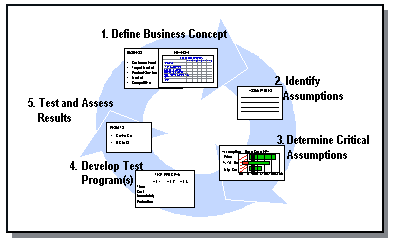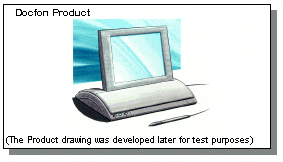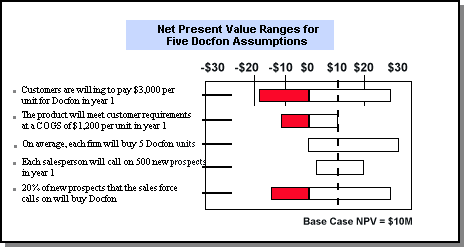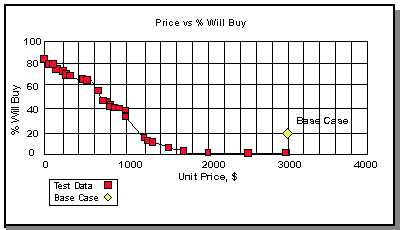Lower Development Costs Through Critical Assumption PlanningSM
Venture capitalists earn good portfolio returns even though as many as 6 of 10 venture starts fail or fall short of expectations. How? They make investments in steps. Each step is measured by some specific accomplishment or “milestone” that will test a significant business plan risk. Using this funding approach, the venture capitalist limits his risk by investing only enough cash to learn the answer to a key uncertainty.
Critical Assumption Planningsm (CAP) is a risk management process1 that adapts the venture capital milestone concept as a five-step process. The process is designed to be used by teams operating in a corporate environment and provides a tighter focus for the now familiar stage/gate process.
CAP helps development teams focus on the key business uncertainties in their project very early. In doing so, they can apply limited resources to testing these uncertainties quickly, thereby avoiding wasted time and development dollars, should the venture prove unsound.
The following description illustrated how CAP was applied by an AT&T venture team (now Lucent Technologies). The venture was called “Docfon” – an abbreviation of “document phone” – started in 1992.

Figure 1
The first step in the cycle is to construct a qualitative snapshot of the concept (customer need, target market, product description, price, competition, channel, etc.).
Next, develop a “back-of-the-envelope” quantitative model of the business (number of customers, unit sales, price, COGS, other expense, etc.). This request unnerves most development teams at this stage. Asked to construct a financial model at the outset, most venture teams exclaim, “We can’t do that yet. After all, how can we set a price if we haven’t yet developed the product concept?”
Our response is – “Just do it!” At the start, there will probably be more assumptions than facts in the model. That’s O.K. The idea is to identify what is known and unknown, what is fact and what is assumption.
Space constraints prohibit showing the financial model here, but an excerpt of the qualitative concept includes:
Need: For simultaneous, interactive voice and document communication between users at different locations regarding a design, drawing, layout, or text document. Currently, customers fax or express mail documents to each other, then wait for a return phone call.
Target market: Project professionals in a field such as advertising or engineering.
Product offer: A display screen, document scanner and electronic pen (see illustration).
Competition: No equivalent, stand-alone product for the desktop, but there could be a PC-based solution.
Channel: The existing direct sales force.

Using the qualitative description and the “back of the envelope” financial model, the team can quickly develop an initial set of assumptions. An assumption is a specific, quantified statement. That is why putting an initial financial model together is valuable. It is, in effect, a summary of all the quantitative facts and assumptions in the business proposition.
The team “guestimated” revenues for the financial model. To develop their assumption list, they then asked themselves what was troubling about their revenue guestimate. Price, they decided, was a concern, but so also was the number of units they would sell. Probing further on units, the team agreed that their real concern related not to how many units each customer would buy, but what percent of the target customers would buy and how soon. So two assumptions on their list became:
- 60% of the target market will be interested in Docfon
- In year one, 20% of those interested will buy two units
Other examples from Docfon’s list of 20 – 30 assumptions included:
- The target market is comprised of 500,000 firms
- The average firm will buy a total of 5 units by the second year after the initial purchase
- The price will be $3,000
- The competition will not arrive to drive down the price until year two
- Sales expense will be the standard 17% of revenues
- The existing sales force can sell this product
- COGS will be $1,200 per unit
The CAP process is not concerned about all assumptions. The focus is on the show-stoppers, the critical assumptions. These are the risky assumptions that must be managed.
To determine whether an assumption is critical the first step is to assess its uncertainty range (i.e., the realistic high and low value). This is done for all assumptions considered potentially dangerous. It is not helpful to just take a standard plus or minus 10% from the most likely scenario when setting the uncertainty range. The cross-functional team needs to apply its experience to think through the most realistic range of variations to get value from the exercise. (In Docfon, for example, the team decided a realistic uncertainty range for pricing was $1,200 and $4,000, or -60% and +33%, respectively, from the base value of $3,000).
A team determines the criticality of an assumption by calculating the net present value (NPV) at the high value and low value, while holding all other assumptions at their base values. An assumption is defined as critical for one of two reasons. Either it has a significant negative impact on the NPV value, or the uncertainty range is so wide that the team clearly does not have a good handle on it.
The team identified five potentially troublesome assumptions which are listed in Figure 2. Figure 2 also shows the NPV “tornado” diagram resulting from plugging in the uncertainty ranges for each assumption. (This tornado chart is a great graphic for management and development teams to discuss at decision gate meetings, in order to get aligned on risk).

Figure 2
It’s not enough just to measure the financial impact of an assumption. The need is to test critical assumptions quickly and economically.
Elimination of all uncertainty is not the goal of an assumption test program. The challenge is to design a test program that gives the most uncertainty reduction (measured by NPV range reduction) per dollar of test cost. The cost includes the incremental cost of running the test, plus the budgeted venture expense and capital costs that will be incurred during the test period.
The critical assumptions to be tested first are determined by their negative impact or their wide range of uncertainty. This contrasts with the conventional approach for corporate developers which is to test assumptions in a linear sequence of milestones from R&D to engineering to manufacturing to marketing to sales.
Various test programs were explored for the critical Price assumption to determine which was the most cost-effective. One suggested test was to show customers a colour brochure describing Docfon and asking their interest at different price points. Another alternative involved building a prototype and letting customers use it before assessing their interest. The team chose the first option. The colour brochure approach did not reduce uncertainty as much as the prototype alternative, but it was far less expensive in time and dollars and would reduce the uncertainty enough to take the assumption off the critical list.
Each CAP learning cycle ends with a venture reassessment. The business plan is updated, replacing earlier assumptions with the facts collected in the recent test program. The business plan for a venture should not become just a sales document to get management approval, and then be shelved until the next corporate budget cycle. This may work for an established business, but not for new ventures. The plan must be updated each time the development team completes a fresh CAP cycle.
During the reassessment, the venture team and management focus on what was learned and make a decision whether to take the next step, change direction, or stop.
Figure 3 shows the test results of the Docfon critical assumption for price. As indicated on the right-hand side of the chart, the Docfon Base Case had assumed 20% of customers would buy at a price of $3,000. On the left are the test results. They show no interest at $3,000 and above, but interest does start at about $1,200 and climbs significantly at $800. The team understood that it could not bring costs down to allow a $1,200 price point using its technology.

Figure 3
Postscript
A year after the Docfon venture terminated, Hewlett-Packard introduced a device almost identical to Docfon in function and priced at $2,595. Called Omnishare, it was advertised for “Engineers, lawyers, designers, ad copywriters, and others can start working on a document together….” The Docfon team naturally wondered whether they had stopped too early, whether they should have tested their concept with a prototype rather than a brochure, whether, perhaps, they should have pressed on regardless of the test results. Eight months later it was announced that Omnishare had been discontinued because of poor sales, despite deep discounts to $1,500.
Summary
There is a way to reduce the costs of product development and get a better return on R&D investment. The key is to get development teams focused earlier on identifying and testing the critical assumptions in the plan. The stage-gate process considers assumptions, but explores them in sequence through the normal, linear development process. This approach can fail to turn up critical assumptions until later stages. The idea behind CAP is to cut through to the critical issues up front and focus the team on managing them sooner.
The learning approach that CAP represents requires changing how development teams operate. Traditionally, corporations treat development teams as they would managers of existing businesses. They measure teams against “meeting plan.” Teams should be judged by the following learning parameters: astute identification of critical assumptions, cost-effective assumption test planning, and creative response to what was learned from the assumption tests.
With a focus on learning and a flexible approach to planning, less time and money is wasted during development and in disappointing market launches.
The authors wish to thank AT&T and Lucent Technologies for permission to illustrate the CAP process with the Docfon case and to Marty Gupta and Tom Prewitt who co-managed the Docfon venture team.
Notes:
1. For a more comprehensive discussion of the CAP process, see “Critical Assumption Planning: A Practical Tool for Managing Business Development Risk,” Journal of Business Venturing, November 1995, by the authors.
Authors: Hollister B. Sykes, Technology Venture Management
David J. Dunham, President, D. Dunham & Company
Critical Assumption PlanningSM is a service mark of D. Dunham & Company.

